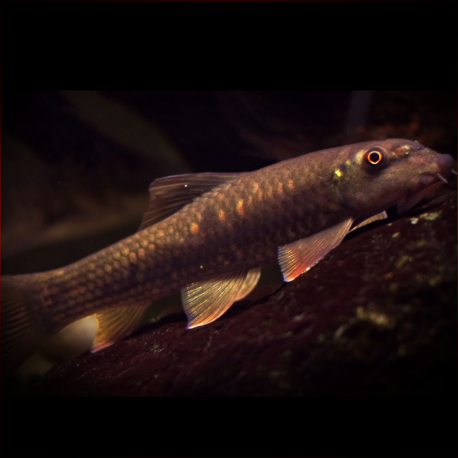More info
Datasheet
| Maximum Size | 17.5cm / 6.89inches |
General Description
Garra qiaojiensis, a species in the Cyprinidae family, is distinguished from closely-related species by its quadrate proboscis configuration and heavily tuberculated anteriorly. It shares similarities with G. rotundinasus but differs in head length, body depth, and anus position. The genus Garra is continually evolving with new taxa described regularly, leading to ongoing confusion in species identification and taxonomy.
Aquarium Setup
Typical habitats for G. qiaojiensis include clear, flowing mountain streams with rock and gravel substrates. When setting up an aquarium for these fish, it is essential to mimic their natural environment by providing a well-oxygenated tank with ample hiding spots among rocks and gravel. Water quality should be closely monitored, with a preference for cooler temperatures and slightly acidic to neutral pH levels (see table).
Behaviour
G. qiaojiensis is known for its adhesive mental disc that enables it to cling to surfaces in turbulent conditions. These fish have adapted ways to feed by using their keratinized jaws to scrape food from the substrate. Some species within the genus Garra have evolved specialized traits, such as reduced eyes in hypogean forms or thermal spring adaptation.
Feeding and Diet
In the wild, G. qiaojiensis feeds by scraping food items from the substrate using their keratinized jaws. When kept in captivity, a diet of high-quality flake, pellet, or sinking foods can be offered. Additionally, occasional feedings of live or frozen foods like bloodworms or brine shrimp can provide essential nutrients and variety to their diet.
Reproduction & Dimorphism
Information on the breeding habits and sexual dimorphism of G. qiaojiensis is limited. Generally, fish in the genus Garra exhibit typical egg-scattering spawning behavior, with males and females displaying subtle differences in coloration or fin shape during the breeding season.
Habitat and Distribution
Garra qiaojiensis is primarily found in the upper Irrawaddy river basin in Yunnan province, China, with possible occurrences in northern Myanmar. The species thrives in clear, flowing mountain streams with rocky substrates, reflecting its natural habitat preferences in the wild.

